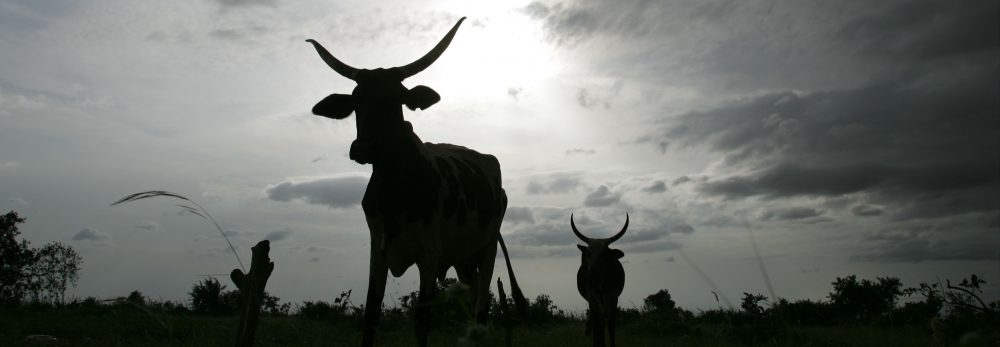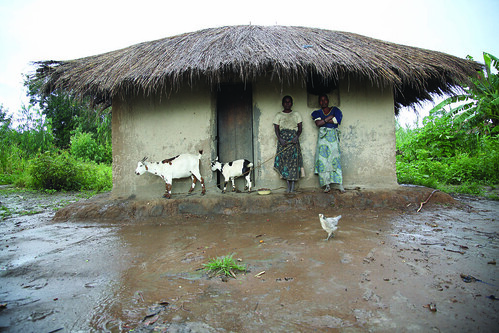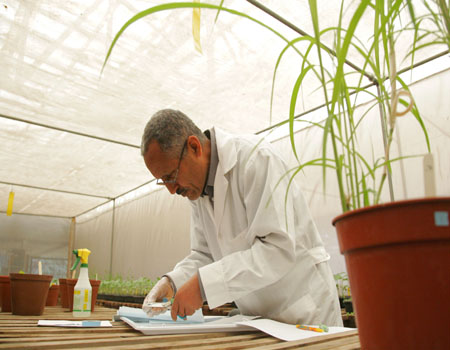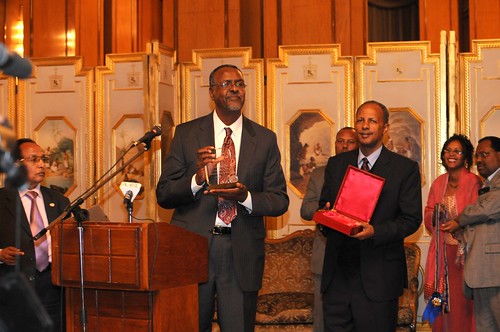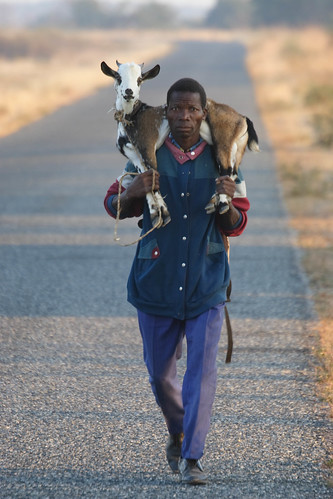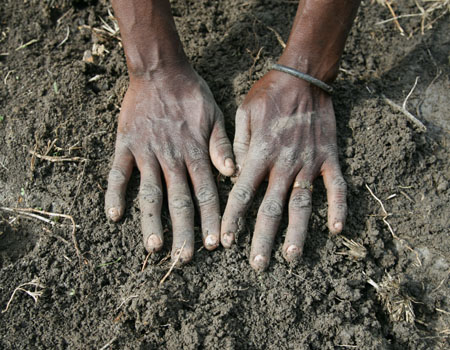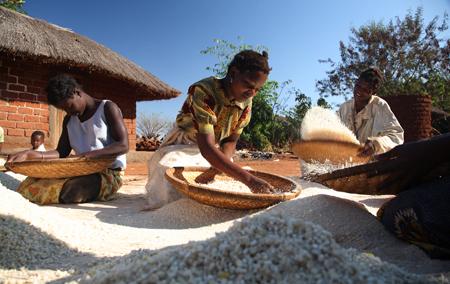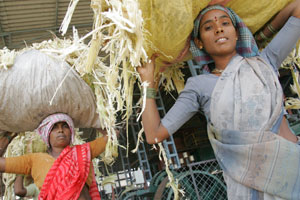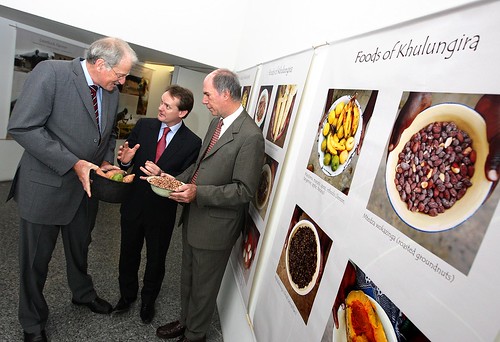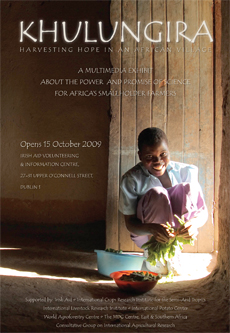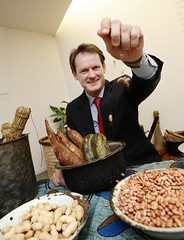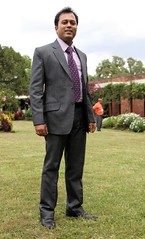 Arindam Samaddar began working for International Livestock Research Institute in October 2009 and this is his first Annual program meeting. 'I'm very excited, both by the research I'm doing in India, and by the opportunity to meet new colleagues here,' he says. Being an anthropologist, he brings new skills to ILRI. When Arindam was studying for his PhD, he coined the term ‘agricultural anthropology’, and that tells you much about where he's coming from. 'I have always been interested in exploring agricultural development from an anthropological perspective,' he explains. His early research in the state of Bihar looked at the different ways three separate communities – Hindus, Muslims and tribal communities – approached agricultural tasks. Later, for his PhD, he studied the impact of technology adoption on rice cultivators in West Bengal. Two years of teaching at Calcutta University was followed by a spell with the International Maize and Wheat Development Center (CIMMYT), where he worked in partnership with ILRI scientists on the crop-livestock interactions in conservation agriculture systems in Bangladesh and India. Now, he is providing an anthropological perspective to the Cereal Systems Initiative in South Asia (CSISA), which aims to boost the cereal production of some 6 million arable farmers. So what attracted him to ILRI? "Anthropologists try to understand whole systems, they don't look at problems in isolation, and I think ILRI has a similar approach," he says. "ILRI also has a strong focus on poverty eradication, and that's something that appeals to me as well." He's also excited by the idea of getting his hands dirty – metaphorically speaking. “Up to now, I’ve always focused on research, but with this project I'm going to be involved, for the first time, in practical interventions to help improve farmers’ livelihoods."
Arindam Samaddar began working for International Livestock Research Institute in October 2009 and this is his first Annual program meeting. 'I'm very excited, both by the research I'm doing in India, and by the opportunity to meet new colleagues here,' he says. Being an anthropologist, he brings new skills to ILRI. When Arindam was studying for his PhD, he coined the term ‘agricultural anthropology’, and that tells you much about where he's coming from. 'I have always been interested in exploring agricultural development from an anthropological perspective,' he explains. His early research in the state of Bihar looked at the different ways three separate communities – Hindus, Muslims and tribal communities – approached agricultural tasks. Later, for his PhD, he studied the impact of technology adoption on rice cultivators in West Bengal. Two years of teaching at Calcutta University was followed by a spell with the International Maize and Wheat Development Center (CIMMYT), where he worked in partnership with ILRI scientists on the crop-livestock interactions in conservation agriculture systems in Bangladesh and India. Now, he is providing an anthropological perspective to the Cereal Systems Initiative in South Asia (CSISA), which aims to boost the cereal production of some 6 million arable farmers. So what attracted him to ILRI? "Anthropologists try to understand whole systems, they don't look at problems in isolation, and I think ILRI has a similar approach," he says. "ILRI also has a strong focus on poverty eradication, and that's something that appeals to me as well." He's also excited by the idea of getting his hands dirty – metaphorically speaking. “Up to now, I’ve always focused on research, but with this project I'm going to be involved, for the first time, in practical interventions to help improve farmers’ livelihoods."
Category Archives: Agriculture
Collective action ‘in action’ for African agriculture
Collaborative agricultural research in Africa gets a welcome boost; village farm household in central Malawi (photo credit: ILRI/Mann).
In recent months, an, initiative of the Consultative Group on International Agricultural Research (CGIAR) called the Regional Plan for Collective Action in Eastern & Southern Africa (now simply called the ‘Regional Collective Action’) updated its ‘CGIAR Ongoing Research Projects in Africa Map’: http://ongoing-research.cgiar.org/ This collaborative and interactive map will be launched in the coming weeks through fliers, displays and presentations at agricultural, research and development meetings that have Africa as a focus. Although much of Africa’s agricultural research information has yet to be captured in this map, 14 centres supported by the CGIAR have already posted a total of 193 research projects and much more is being prepared for posting.
The newsletter of the Regional Collective Action—Collective Action News: Updates of agricultural research in Africa—continues to elicit considerable interest and feedback. Recent issues reported on the CGIAR reform process (November 2009) and agriculture and rural development at the recent climate change talks in Copenhagen (December 2009). The January 2010 issue reflects on the achievements of the Regional Collective Action since its inception three years ago (https://www.ilri.org/regionalplan/documents/Collective Action News January 2010.pdf).
Several high-profile African networks, including the Forum for Agricultural Research in Africa (FARA), the Food, Agriculture and Natural Resources Policy Analysis Network (FANRPAN) and the Association for Strengthening Agricultural Research in Eastern and Central Africa (ASARECA), are helping to disseminate the newsletter of the Regional Collective Action as well as information about its consolidated multi-institutional research map. Coordinators have now been appointed to lead each of four flagship programs of the Regional Collective Action.
Flagship 1 conducts collaborative work on integrated natural resource management issues and is coordinated by Frank Place at the World Agroforestry Centre (ICRAF).
Flagship 2 conducts research on agricultural markets and institutions and is led by Steve Staal of ILRI.
Flagship 3 conducts research on agricultural and related biodiversity and is led by Wilson Marandu of Bioversity International with support from Richard Jones of the International Crops Research Institute for the Semi-Arid Tropics (ICRISAT).
Flagship 4 conducts research on agriculturally related issues in disaster preparedness and response and is led by Kate Longley and Richard Jones of ICRISAT.
These four flagships programs of the Regional Collective Action are expected to play crucial roles in advancing collaborative discussions and activities in the new CGIAR, which is transforming itself to better link its agricultural research to development outcomes. ILRI’s Director of Partnerships and Communications, Bruce Scott, represented the CGIAR Centres at the December Meeting of the ASARECA Board of Trustees.
‘ASARECA continues to value the work of the CGIAR Centres in this region and welcome the Regional Collective Action,’ Scott said. With the four Flagship Programs off and running, the interactive Regional Research Map live on the web, and Collective Action News reporting on regional agricultural issues regularly, collaborative agricultural science for development in Africa appears to have got a welcome boost.
Swedish International Development Agency grants US$10.67 million to improve African bioscience
Bio-resources Innovations Network for Eastern Africa Development (Bio-Innovate) announce USD10.67 million grant from the Swedish International Development Agency (Sida).
The New Partnership for Africa’s Development (NEPAD) and the International Livestock Research Institute (ILRI) today announced a SEK80 million (USD10.67 million) grant from the Swedish International Development Agency (Sida) to support the set up of a multidisciplinary competitive funding mechanism for biosciences and product-oriented innovation activities in eastern Africa (Burundi, Ethiopia, Kenya, Rwanda, Tanzania and Uganda).
The Bio-Innovate Program will focus on delivering new products through bioscience innovation systems involving a broad sector of actors, including scientists, the private sector, NGOs and other practitioners. The program will use modern bioscience to improve crop productivity and resilience to climate change in small-scale farming systems, and improve the efficiency of the agro-processing industry to add value to local bio-resources in a sustainable manner. Bio-Innovate will be user-, market- and development-oriented in order to make a difference on the ground in poverty alleviation and sustainable economic growth.
Ibrahim Assane Mayaki, Chief Executive Officer of the NEPAD Planning and Coordinating Agency, says: “African governments have recognized the importance of regional collaboration in science and technology to enable the continent to adapt the rapid advances and promises of modern biosciences. In 2005, under the auspices of the Africa Union (AU) and NEPAD, African countries designed and adopted Africa´s Science and Technology Consolidated Plan of Action (CPA). The plan puts emphasis on improving the quality of African science, technology and innovation through regional networking and developing more appropriate policies. Biotechnology and biosciences are prioritized areas in the plan, as has been demonstrated by the work of a high-level AU/NEPAD African Panel on Biotechnology, whose findings are in the publication Freedom to Innovate—Biotechnology in Africa´s Development.”
An Africa-based and Africa-led initiative, Bio-Innovate will draw upon existing expertise and resources from Africa, while forming connections with both African and global institutions to add value to Africa’s natural resources and develop sound policies for commercializing products from biosciences research.
Bio-Innovate builds on the achievements of the BIO-EARN program funded by Sida from 1999 to 2009 and has been developed by a team appointed by BIO-EARN governing board. “The program will benefit a lot from the facilities available at the Biosciences eastern and central Africa (BecA) Hub”, says Hassan Mshinda, Chair of the BIO-EARN Governing Board.
“We recognize the importance of the Bio-Innovate initiative to complement and strengthen the biosciences research in eastern and central Africa,” says Carlos Seré, Director General of ILRI. “We appreciate the support from Sida and are convinced that this innovative program will strengthen Africa’s capacity in using biotechnology for economic development.”
“Sida sees the Bio-Innovate Program as an important platform for pooling eastern African expertise through a regional bioscience innovation network, enabling cross-sectoral and interdisciplinary R&D and policy and sustainability analysis. The Bio-Innovate Program will be integrated into ongoing regional programs and structures and promote bioscience innovation in support of sustainable development in the region”, says Gity Behravan, Senior Research Advisor at Sida.
Notes:
New Partnership for Africa’s Development (NEPAD): The New Partnership for Africa’s Development (NEPAD) is a socioeconomic development program of the African Union (AU). The objective of NEPAD is to stimulate Africa’s development by filling gaps in agriculture, health, education, infrastructure, science and technology. NEPAD explicitly recognizes that life sciences and biotechnology offer enormous potential for improving Africa’s development. Through NEPAD, African countries have committed themselves to establish networks of centres of excellence in biosciences. Four sub-regional networks have been established: the Southern African Network for Biosciences (SANBio), the Biosciences Eastern and Central Africa Network (BecANet), the West Africa Biosciences Network (WABNet) and the North Africa Biosciences Network (NABNet). A recent AU decision to integrate NEPAD into structures and processes of the AU gives the NEPAD Planning and Coordinating Agency (NPCA) the mandate to facilitate, coordinate and implement the NEPAD agenda.
International Livestock Research Institute (ILRI): The Africa-based International Livestock Research Institute (ILRI) works at the crossroads of livestock and poverty, bringing high-quality science and capacity building to bear on poverty reduction and sustainable development. ILRI is one of 15 centres supported by the Consultative Group on International Agricultural Research (CGIAR). It has its headquarters in Kenya and a principal campus in Ethiopia. It also has teams working out of offices in Nigeria, Mali, Mozambique, India, Thailand, Indonesia, Laos, Vietnam and China. ILRI hosts the Biosciences eastern and central Africa (BecA) Hub at the invitation of the African Union/New Partnership for Africa’s Development (AU/NEPAD), as part of the AU/NEPAD’s Africa Biosciences Initiative. The BecA Hub is part of a shared research platform on the ILRI campus in Nairobi. The BecA Hub has been established over the past two years, with strong support from the Government of Canada, through the Canadian International Development Agency (CIDA), and ILRI. For more information, please visit our website: www.ilri.org
Special policy seminar on Millions Fed held at ILRI Nairobi campus
Learning from successes in agricultural development is now more urgent than ever. Progress in feeding the world’s billions has slowed, while the challenge of feeding its future millions remains enormous and is subject to new uncertainties in the global food and agricultural systems. Recently ILRI Nairobi had the pleasure of hosting a special policy seminar titled Millions Fed: Proven Successes in Agricultural Development, organized by The International Food Policy Research Institute (IFPRI) and CGIAR Collective Action for ESA. The key speaker was Dr. David Spielman, one of the authors of Successes in Agricultural Development: Lessons Learned from Millions Fed, a study from IFPRI, with support from The Bill & Melinda Gates Foundation, embarked on to identify and assess interventions in agricultural development that have substantially reduced hunger and poverty; to document evidence about where, when and why these interventions succeeded; to learn about the key drivers and factors underlying success; and to share lessons to help inform better agricultural policy and investment decisions in the future. Following a rigorous review process, the project ultimately identified 20 proven successes in agricultural development, several of which highlight policies, programs and investments in sub-Saharan Africa. This event presented what worked, why it worked and what we can learn from these successes. Decisions rotated around topics of importance on communicating successes in agricultural development, accumulating rigorous evidence on agricultural development and continued investment in agricultural development. Visit www.ifpri.org/millionsfed further details.
Agricultural research ‘masterplan’ unveiled
[COPENHAGEN] A “masterplan” for agricultural research and technology transfer was unveiled at the UN Climate Change Conference in Copenhagen today by the Consultative Group on International Agricultural Research (CGIAR), the world’s largest alliance of agricultural scientists.
The 45-page strategy calls for, on the one hand, action that harnesses multiple advances that the group says are waiting to be rolled out. The second strand is to boost research into longer-term solutions.
The report thus calls for an intensive effort to “speed the development and dissemination of dozens of existing improved technologies”, including hardier crop varieties and more efficient ways to manage water, trees, soils, livestock, fish and forests. These have emerged from more than 30 years of research, the group says.
“Turning this wealth of knowledge into action will create immediate benefits, bolstering food security and adapting agriculture to climate change impacts in the near term, while mitigating future impacts through reduced greenhouse gas emissions,” said Thomas Rosswall, chair of the CGIAR Challenge program on climate change, agriculture and food security.
“A quick response now will also buy us time to develop the more potent climate change solutions that will be needed 10 years from now.”
CGIAR experts also argued that the proposed adaptation fund “to enable developing countries to cope with the impacts of climate change“ should cover agriculture.
“Agriculture is part of the [climate change] problem and part of the solution,” said Rosswall.
Agriculture contributes to a third of the total global greenhouse gas emissions but is also highly vulnerable to changes in temperature and rainfall, and extreme weather events.
An International Food Policy Research Institute (IFPRI) analysis published this month (December) predicts a 10–40 per cent decline in crop yields by 2050. Food prices are projected to rise by 30–70 per cent by 2050 even without climate change and by an additional 30–100 percent due to the impact of climate change.
The CGIAR report highlighted the use of computer modelling to inform decisions about difficult trade-offs, such as those between environmental impacts and socioeconomic benefits in the global livestock sector.
The International Livestock Research Institute (ILRI) in Nairobi, for example, is modelling ways of making crop and livestock production more profitable without depleting natural resources, said Philip Thornton, senior scientist at ILRI.
It has prepared maps indicating where the environmental pressures of such production are most intense.
Computer simulations are also helping to explore the potential of crop substitution, for example, replacing beans, a major crop that is declining in many parts of sub-Saharan Africa, with the more drought-tolerant cassava.
Ethiopian president bestows his nation’s highest award on Ethiopian sorghum breeder and 2009 world food prize winner, Gebisa Ejeta
Scientist whose work has enhanced the food supply of hundreds of millions of people
in sub-Saharan Africa is honoured in Ethiopia
At a reception at the National Palace in Addis Ababa, Ethiopia, following a ‘Dialogue on Agricultural Development in Ethiopia’ on 12 November 2009, Ethiopia’s president, H.E. Ato Girma Woldegiorgus, bestowed his country’s highest award for achievement on Prof Gebisa Ejeta, an Ethiopian-born sorghum breeder and recent World Food Prize Laureate. In response, Prof Ejeta announced that he will use his USD250,000 World Food Prize award to establish a foundation that will help meet the educational needs of Ethiopian and other African children and to establish an annual dialogue in honour of his friend and mentor, Dr Berhane Gebre-Kidan, formerly of Ethiopia’s Alemaya College of Agriculture.
At his Palace reception, Ejeta was visibly moved by his country’s honour.
‘To receive from my country the highest recognition any Ethiopian can receive is overwhelming,’ said Ejeta. ‘All other recognitions I have received I have taken on behalf of the causes I have served. But I am happy to take this particular recognition personally.’
Ejeta, a self-described ‘typical Ethiopian’, said he had spent his life working to serve three principles: humility, integrity and loyalty. ‘I have always tried to remain in check with myself, my own sense of purpose,’ he said. ‘You have to have some cause bigger than yourself. Mine has been to work in service of humanity and the poor.’
Ejeta said, ‘With the money I received from the World Food Prize, I am putting together a foundation. We will use this award money to help meet the educational needs of Ethiopia and other African children.’
He then went on to make a second announcement.
‘Dr Berhane Gebre-Kidan has served as a friend and mentor since I met him at my alma mater, the Alemaya College of Agriculture. I want to establish an annual dialogue, the “Berhane Gebre-Kidan Dialogue”. I cannot think of a better venue to make this announcement, honouring my mentor.’
The 2009 World Food Prize was presented to the Ethiopian-born plant scientist, now an American citizen conducting research at Purdue University, in ceremonies in Des Moines, Iowa, on 15 October 2009. The prize, which comes with a USD250,000 award, is given annually to people who have helped address the world’s food needs. This year’s prize honours Ejeta’s life-long work to improve the production of sorghum, one of the world’s most important grain crops. It also honours his efforts to make his discoveries matter to the farmers who need them the most.
Humility
Ejeta’s desire to help others is rooted in his own childhood poverty. He grew up in a one-room thatched hut in rural Ethiopia. His mother’s commitment to his education helped make him a standout. Poor as she was, she found a place for Ejeta to study, and a place to stay, in a town 20 kilometres away. Ejeta walked there. He studied there. He worked hard there. He excelled there.
Lowell Hardin, an emeritus professor at Purdue University who has known Ejeta for 25 years, says, ‘Because he grew up in very, very modest circumstances — a single mother in a remote village in Ethiopia — he knew poverty. He knew hunger. And when he was fortunate enough to get an education thanks to his mother’s pushing, he decided he was going to apply his talents in this direction.’
Integrity
Ejeta has spent his entire professional life in research to reduce threats to Africa’s food crops. He applied his talents to fighting a weed called Striga, or witchweed, which threatens crops that feed more than 100 million people across sub-Saharan Africa. Ejeta says the parasitic weed can ruin fields of sorghum, a major staple in hot, dry regions of Africa.
‘If you grow a crop susceptible to infection by the parasite,’ he says, ‘and if your soil is contaminated, you have no chance of growing a crop. And most of these soils are becoming contaminated.’
Researchers had tried for years to control the weed without much success. Its seeds can lie dormant in the soil for decades. But Ejeta and his team at Purdue University discovered the chemical signals produced by the sorghum plant that ‘wakes up’ the Striga seeds. They then found sorghum varieties that didn’t produce the signals, and bred a line of Striga-resistant plants that thrived in a broad range of African growing conditions. These new varieties produced up to four times more grain than local types, even in drought-plagued areas.
Loyalty
With this research breakthrough, Ejeta immediately set about ensuring that his disease- and drought-resistant varieties were made available to the African farmers who needed them most. Once the new variety was developed in 1994, he worked with non-profit groups to distribute eight tons of seed to twelve African nations.
Carrying research to the next level is typical of Gebisa Ejeta, who has always understood the importance of getting technology into the hands of African farmers. Just out of graduate school, he bred a high-yielding, drought-tolerant variety of sorghum. When the new hybrid variety was introduced in 1983, Ejeta worked with Sudanese farmers’ cooperatives to scale up production of his drought-resistant sorghum.
Today, Ejeta is working with local partners to connect brewers, bakers, and flour millers with farmers growing the improved sorghum. By working along the entire chain, from farmers’ seeds to consumers’ plates, his work is helping to lift people out of poverty—and providing a powerful weapon in the war on hunger.
Dialogue
The 12 November 2009 ‘Dialogue on Agricultural Development in Ethiopia’ was organized by the Ethiopian Ministry of Agriculture and Rural Development in Ejeta’s honour. Supported by the International Livestock Research Institute and other organizations, the Dialogue was opened by H.E. Ato Girma Woldegiorgis, President of the Federal Republic of Ethiopia.
President Woldegiorgis called Ejeta ‘an Ethiopian champion whose prize is a commitment to others. Through much of our history, we have made scientific discoveries. With this recognition of Dr Gebisa, we reclaim that history.’
In his welcome address, H.E. Ato Teferra Derebew, Minister of Agriculture and Rural Development, noted how much the Ethiopian Government has emphasized agriculture in its development program and said, ‘Gebisa represents a new generation of agricultural researchers. The farming and pastoral societies of Ethiopia are grateful.’
Ejeta on Ethiopia’s challenges and opportunities
In his presentation, Prof Ejeta spoke about Ethiopia’s role in enhancing science-based development in Africa. Whereas most African governments have invested too little to create impact, he said, Ethiopia is an exception.
‘No other African country has committed more internal resources to agricultural development,’ Ejeta said. ‘I have grown positive about Africa lately. Ethiopia is at the cusp of a major agricultural revolution. Ethiopians are among the most resourceful people I know. They can focus and get it done.’
He extolled two great examples of technology transfer in Ethiopia: the Chilalo Agricultural Development Unit in 1970s and the work of Sasakawa Global 2000 in 1990s. ‘Neither,’ he said, ‘was sustained.’ Why not?
‘I am defined,’ Ejeta said, ‘by the modest background that I come from and the great education that I have received in both Ethiopia and the United States.’ In his experience, he said, both Alemaya College of Agriculture and Purdue University shared a ‘land grant university model’ that takes the results of research and delivers it to communities.
‘More buildings and more students don’t make a college,’ he warned. ‘The quality of education in Africa needs to be improved. We need to go back to the model we used 40–50 years ago. We need to get our colleges linked to outstanding universities overseas. The most significant mark that we can make is capacity strengthening.’
Among his worries, Ejeta said, were an uncoordinated national agricultural research framework and what he called the ‘seasonality and fragmentation of development efforts.’
‘For too long we have relied on external funding,’ he said. He warned of the tendency of non-governmental organizations to lobby for boosting social service spending and the susceptibility of donors to embracing paradigm shifts, from sustainable agriculture in the 1990s, for example, to today’s integrated value chain approach. Such frequently changing paradigms, he said, ‘have led to a series of failed starts and are partly responsible for our lack of traction on the ground in agricultural research for development.’
‘African science-led agricultural development needs to be country led,’ he said. ‘Our country programs must be front and centre, with international agricultural research institutes and non-governmental organizations working to support them.’
Ejeta advised the Ethiopian agricultural research-for-development community to ‘Loosen up, be open and take risks’ and to focus on three things: accelerating technological development, investing in institutions and pushing for policy and ownership.
Panel on climate change and African agriculture
Three other presentations on the achievements and future of Ethiopian agriculture and agricultural research were followed by a panel discussion. Several of the panel members spoke on the new challenges Ethiopian and African food producers face with climate change. Dr Mata Chipeta, working for the Food and Agriculture Organization of the United Nations in its Ethiopia sub-regional office, said, ‘Climate change is likely to worsen our food security problems. Climate change could become just the latest excuse for Africa not to be food sufficient. Last year’s fuel price hikes and then fertilizer, food and financial crises are all interlinked. Africa must become master in its own house. It must stop feeling entitled to free assistance. It must invest its own resources. Only then will we get a future that we drive.’
Dr Carlos Seré, director general of the International Livestock Research Institute (ILRI), whose principal campuses are located in Ethiopia and Kenya, spoke of the need to enhance the capacity of societies to learn quickly and respond to climate and other changes. ‘I don’t think there is a trade-off between climate change and food security,’ Seré said. ‘Our agricultural and climate challenges have much in common. Agriculture has to be central to climate change discussions.’
The ILRI director general remarked on Ethiopia’s rare agricultural, biological, human and institutional diversity: ‘There will be a lot of variability in how the climate changes. Ethiopia has greatly diverse farming regions. It has great biodiversity. How can we use cutting edge science to understand that diversity and use it better? Lessons learned in one place may be valuable in another. We need to empower people at the local level to provide solutions. Science can quicken this work. The centres of the CGIAR have been working side by side with the Ethiopian Institute of Agricultural Research and other institutions in this country. We stand ready to deepen our cooperation with the diversity of institutions in Ethiopia.’
Regular dialogue begins
Fittingly, the person whose remarks closed the Dialogue was Prof Ejeta’s mentor, Dr Berhane Gebre-Kidan, who had attended the October World Food Prize ceremony in Iowa, where he watched his protégé be honoured.
Recalling that Ejeta had attended Jimma Agricultural Technical University, Alemaya Agricultural University and then Purdue University, Gebre-Kidan said that each of these institutions shared the land grant philosophy, which combines education, research, and extension, all involved in the development of its local communities.
‘I wait for the day,’ Gebre-Kidan said, ‘when this triangle is recognized in each of our colleges of agriculture. We are recognized as a country unable to feed itself. We have to change that image. We have a world-class scientist in the person of Prof Gebisa Ejeta, which we can exploit. We need to establish a think tank that will think outside the box about Ethiopian agriculture. We need to institute a regular dialogue to move Ethiopian agriculture forward.’
It appears from Gebisa Ejeta’s announcement at Ethiopia’s National Palace that that ‘regular dialogue’ is about to begin.
Support for the Dialogue honouring Prof Ejeta was provided by the Ethiopian Government as well as the Alliance for a Green Revolution in Africa, the Canadian International Development Agency, the International Development Research Centre (Canada), the International Livestock Research Institute, the Japanese International Cooperation Agency, OXFAM America, OXFAM Great Britain and the United States Agency for International Development.
For more information about the 12 November 2009 Dialogue in Addis Ababa, go to: www.ilri.org/ilrinews/index.php/archives/tag/dialogue
For more information about Prof Gebisa Ejeta, go to: World Food Prize Laureate.
Putting livestock food on the climate-change table
It’s time for climate negotiators to put meat on the bones
of the next climate agreement
By Carlos Seré, Director General, ILRI
Worldwide our climate is changing, and livestock, which are vital to food security and to agricultural systems in most marginal regions of the world, must adapt to survive, as must the herders and farmers who keep them.
Livestock systems are a major global asset. They occupy 45% of the earth’s surface, employ at least 1.3 billion people, and are valued at about 1.4 trillion US dollars. They provide 17% of the calories and a third of the protein we consume. According to FAO, milk is the world’s number one agricultural commodity, worth about $144 billion annually, and meat from cows, pigs and chickens rank 3, 4 and 5, respectively.
These statistics, however, hide stark differences in how livestock are raised. In poor countries, most livestock are raised on small farms or herded by pastoralists. Throughout their (usually long) natural lives, they survive largely on grass and other vegetation, including the stalks, leaves and other ‘wastes’ of food crops after the grain has been harvested.
In contrast, most livestock in wealthy countries are ‘factory-farmed’ using industrial processes. These short-lived animals are quickly fattened by feeding them vast quantities of corn and other grains – food that could be eaten by people.
Livestock contribute about 18% of the global greenhouse gas emissions generated by human activity. The vast majority of these emissions come from wealthy countries practicing factory farming. All of Africa’s ruminants combined, for example, account for only 3 percent of the global methane emissions from livestock.
Most farmers in developing countries practice either mixed-crop and-livestock farming or pastoral production on rangelands. These smallholders and herders leave tiny environmental footprints in terms of inputs. Even so, investments that increase their efficiency and productivity in terms of breeding and feeding could remove millions of tons of methane and carbon emissions from the atmosphere.
Livestock play central roles in the lives of the poor. If livestock are lost, households can slip into chronic “poverty traps”. Experts believe that climate change is particularly hurting Africa’s livestock and other food producers and the ecosystems on which they depend. And they predict things are going to get worse on the continent, probably much worse. The productivity of rain-fed cropping systems is likely to drop, and do so dramatically in some areas; water shortages will become more common; and important human, livestock and crop diseases are likely to spread to new regions and become more severe.
Many of the world’s small-scale livestock keepers will have to adapt, for example, by changing the mix of livestock species they keep and the types of crops they grow, or switching to new sources of feed for their animals. Some will probably have to get out of agriculture altogether.
When negotiators meet later this year in Copenhagen to finalize the global climate pact, they must pay attention to the many small farmers and herders who are already feeding most of the world’s poor. And they must begin to pay attention explicitly to farm animals that remain neglected by policymakers even as they become increasingly important to food security and raising smallholder incomes. African negotiators in particular need to be champion the cause of small-scale animal agriculture, which remains the backbone of their nations’ economies.
Food security and climate change are inextricably linked. Policymakers must become adept at moving on both fronts simultaneously. And if our climate negotiators hope to address the needs of more than a billion animal keepers n the world, they must begin to provide differentiated policies that support rather than neglect the multifarious small livestock enterprises that make food production possible throughout the developing world.
Dialogue on Ethiopia’s Agricultural Development honours World Food Prize Laureate Gebisa Ejeta
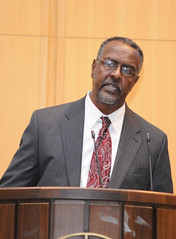 On 12 November 2009, Prof Gebisa Ejeta, winner of the 2009 World Food Prize, contributed to a ‘Dialogue on Agricultural Development in Ethiopia’.
On 12 November 2009, Prof Gebisa Ejeta, winner of the 2009 World Food Prize, contributed to a ‘Dialogue on Agricultural Development in Ethiopia’.
Organized in his honor by the Ethiopian Ministry of Agriculture and Rural Development, the Dialogue was opened by H.E. Ato Girma Woldegiorgis, President of Federal Democratic Republic of Ethiopia, with a welcome address from H.E. Ato Teferra Derebew, Minister for Agriculture and Rural Development.
The program included the following presentations.
- ‘Enhancing Science-based Development in Africa: Where Does Ethiopia Stand? – Prof Gebisa Ejeta
- ‘Achievements and Challenges in Ethiopian Agriculture’ – H.E. Dr. Abera Deresa, State Minister, Ministry of Agriculture and Rural Development
- ‘The Role of Agricultural Institutions of Higher Learning in Producing the Next Generation Agricultural Leaders in Ethiopia – Dr Solomon Assefa, Director General, Ethiopian Institute of Agricultural Research
- ‘The Role of Agricultural Universities in Creating the Next Generation of Agricultural Leaders in Ethiopia’ – Prof Belay Kassa, President, Haramaya University
These presentations were followed by a panel discussion with contributions from H. E. Tumusiime Rhoda Peace (African Union Commission), Dr. Mata Chipeta (Food and Agriculture Organization of the United Nations); Dr. Carlos Seré (International Livestock Research Institute); and Dr. Yilma Kebede (Bill & Melinda Gates Foundation).
The Dialogue closed with remarks by Dr. Connie Freeman (International Development Research Centre), Dr. Bashir Jama (Alliance for a Green Revolution for Africa), and Dr. Berhane Gebre Kidan.
Support for the Dialogue honouring Prof Ejeta was provided by the Ethiopian Government as well as the Alliance for a Green Revolution in Africa, the Canadian International Development Agency, the International Development Research Centre (Canada), the International Livestock Research Institute, the Japanese International Cooperation Agency, OXFAM America, OXFAM Great Britain and the United States Agency for International Development.
For more information about Prof Gebisa Ejeta, this year’s World Food Prize Laureate, please go to:Â World Food Prize Laureate.
See presentations and photos from the dialogue.
New study warns that climate change could create agricultural winners and losers in East Africa
As African leaders prepare to present an ambitious proposal to industrialized countries for coping with climate change in the part of the world that is most vulnerable to its impacts, a new study points to where and how some of this money should be spent. Published in the peer-reviewed journal Agricultural Systems, the study projects that climate change will have highly variable impacts on East Africa’s vital maize and bean harvests over the next two to four decades, presenting growers and livestock keepers with both threats and opportunities.
Previous estimates by the study’s authors projected moderate declines in the production of staple foods by 2050 for the region as a whole but also suggested that the overall picture disguises large differences within and between countries. The new findings provide a more detailed picture than before of variable climate change impacts in East Africa, assessing them according to broadly defined agricultural areas.
‘Even though these types of projections involve much uncertainty, they leave no room for complacency about East Africa’s food security in the coming decades,’ said the lead author of the new study, Philip Thornton of the International Livestock Research Institute (ILRI), which is supported by the Consultative Group on International Agricultural Research (CGIAR). ‘Countries need to act boldly if they’re to seize opportunities for intensified farming in favored locations, while cushioning the blow that will fall on rural people in more vulnerable areas.’
The researchers simulated likely shifts in cropping, using a combination of two climate change models and two scenarios for greenhouse gas emissions, together with state-of-the-art models for maize and beans, two of the region’s primary staple foods.
In the mixed crop-livestock systems of the tropical highlands, the study shows that rising temperatures may actually favor food crops, helping boost output of maize by about half in highland ‘breadbasket’ areas of Kenya and beans to much the same degree in similar parts of Tanzania. Meanwhile, harvests of maize and beans could decrease in some of the more humid areas, under the climate scenarios used in the study. Across the entire region, production of both crops is projected to decline significantly in drylands, particularly in Tanzania.
‘The emerging scenario of climate-change winners and losers is not inevitable,’ said ILRI director general Carlos Seré. ‘Despite an expected three-fold increase in food demand by 2050, East Africa can still deliver food security for all through a smart approach that carefully matches policies and technologies to the needs and opportunities of particular farming areas.’
At the Seventh World Forum on Sustainable Development, held recently in Ouagadougou, Burkina Faso, African leaders announced a plan to ask the industrialized world to pay developing countries USD67 billion a year as part of the continent’s common negotiating position for December’s climate talks in Copenhagen.
The ILRI study analyzes various means by which governments and rural households can respond to climate change impacts at different locations. In Kenya, for example, the authors suggest that shifting bean production more to the cooler highland areas might offset some of the losses expected in other systems.
Similarly, Tanzania and Uganda could compensate for projected deficits in both maize and beans through increased regional trade. In the Common Market for Eastern and Southern Africa (COMESA), maize trade is already worth more than USD1 billion, but only 10 percent of it occurs within the region. As grain prices continue to rise in global markets, several East African countries will be well positioned to expand output of maize and beans for regional markets, thus reducing reliance on imports and boosting rural incomes.
Where crop yields are expected to decline only moderately because of climate change, past experience suggests that rural households can respond effectively by adopting new technologies to intensify crop and livestock production, many of which are being developed by various CGIAR-supported centres and their national partners.
Drought-tolerant maize varieties, for example, have the potential to generate benefits for farmers estimated at USD863 million or more in 13 African countries over the next 6 years, according to a new study carried out by the International Maize and Wheat Improvement Center (CIMMYT) and International Institute of Tropical Agriculture (IITA). Meanwhile, new heat-tolerant varieties of productive climbing beans, which are traditionally grown in highlands, are permitting their adoption at lower elevations, where they yield more than twice as much grain as the bush-type beans grown currently, according to Robin Buruchara of the International Center for Tropical Agriculture (CIAT).
In areas that face drastic reductions in maize and bean yields, farmers may need to resort to more radical options, such as changing the types of crops they grow (replacing maize, for example, with sorghum or millet), keeping more livestock or abandoning crops altogether to embrace new alternatives, such as the provision of environmental services, including carbon sequestration.
This latter option could become a reality under COMESA’s Africa Biocarbon Initiative, which is designed to tap the huge potential of the region’s diverse farmlands and other rural landscapes, ranging from dry grasslands to humid tropical forests, for storing millions of tons of carbon. The initiative offers African negotiators an appealing option in their efforts to influence a future climate change agreement.
‘If included in emissions payment schemes, this initiative could create new sources of income for African farmers and enhance their resilience to climate change,’ said Peter Akong Minang, global coordinator of the Alternatives to Slash-and-Burn (ASB) Programme at the World Agroforestry Centre. ‘Its broad landscape approach would open the door for many African countries to actively participate in, and benefit from, global carbon markets.’
‘Rural people manage their livelihoods and land in an integrated way that encompasses many activities,’ said Bruce Campbell, director of the CGIAR’s Challenge Program on Climate Change, Agriculture and Food Security. ‘That’s why they need integrated options to cope with climate change, consisting of diverse innovations, such as drought-tolerant crops, better management of livestock, provision of environmental services and so forth.’
How rapidly and successfully East African nations and rural households can take advantage of such measures will depend on aggressive new investments in agriculture, CGIAR researchers argue. According to a recent study by the International Food Policy Research Institute (IFPRI), it will take about USD7 billion annually, invested mainly in rural roads, better water management and increased agricultural research, to avert the dire implications of climate change for child nutrition worldwide.
About 40 per cent of that investment would address the needs of sub-Saharan Africa, where modest reductions projected for maize yields in the region as a whole are expected to translate into a dramatic rise in the number of malnourished children by 2050. Thornton’s projections probably underestimate the impacts on crop production, because they reflect increasing temperatures and rainfall changes only and not greater variability in the weather and growing pressure from stresses like drought and insect pests.
‘Farmers and pastoralists in East Africa have a long history of dealing with the vagaries of the weather,’ said Seré. ‘But climate change will stretch their adaptive capacity beyond its limits, as recent severe drought in the region has made abundantly clear. Let’s not leave rural people to fend for themselves but rather invest significantly in helping them build a more viable future.’
###
About ILRI:
The Africa-based International Livestock Research Institute (ILRI) works at the crossroads of livestock and poverty, bringing high-quality science and capacity-building to bear on poverty reduction and sustainable development. ILRI is one of 15 centers supported by the Consultative Group on International Agricultural Research (CGIAR). It has its headquarters in Kenya and a principal campus in Ethiopia. It also has teams working out of offices in Nigeria, Mali, Mozambique, India, Thailand, Indonesia, Laos, Vietnam and China. www.ilri.org.
About the CGIAR: The CGIAR, established in 1971, is a strategic partnership of countries, international and regional organizations and private foundations supporting the work of 15 international Centers. In collaboration with national agricultural research systems, civil society and the private sector, the CGIAR fosters sustainable agricultural growth through high-quality science aimed at benefiting the poor through stronger food security, better human nutrition and health, higher incomes and improved management of natural resources. www.cgiar.org
What a 5-degree world will look like in Africa
At the end of September 2009, Phil Thornton, agricultural systems analyst at the International Livestock Research Institute (ILRI), made a presentation at an international climate conference in Oxford called ‘Four Degrees & Beyond.’ The research he presented was conducted with Thornton’s long-term colleague, Peter Jones, of Waen Associates (UK).
Thornton and Jones have looked at the probable impacts of climate change on agriculture in sub-Saharan Africa and what needs to be done about this. Africa’s population will grow from 0.8 billion today to some 1.8 billion by 2050. Already, over 40% of Africans live in urban areas, and this urbanization will only increase in future, greatly increasing the continent’s need for food to feed all its urban dwellers.
The prognosis for agriculture is mixed in Africa, where yields per hectare have already stagnated. Climate change is critically important to Africa because the gross domestic product and levels of rainfall are highly correlated here. Any change in rainfall and rainfall variability is likely to bring associated economic change. Given all this, the authors asked themselves if ‘it can all be held together’ in the future.
Several research studies indicate that yields of major cereals will be reduced by 10 to 30% to mid-century and beyond, although yields will vary widely depending on the crop grown and the location of the farming system. Regarding the impacts of a temperature increase of 5-degrees centigrade on growing seasons and crop yields, southern Africa is likely to experience 20% or more losses in length of growing periods. Thornton said we can expect under a 5 degree C increase many more ‘failed seasons’ in the 2090s, especially in southern Africa, the northern Sahel and the Horn of Africa. Most of rainfed agriculture in regions south of the Zambezi River is likely to become unviable and in much of East Africa, maize yields could fall by 26% and beans by 54%.
Prognosis
A 5-degree centigrade temperature increase will thus increase crop failure in much of sub-Saharan Africa, which will then require massive increases in intensive cropping in the highlands to feed all the people living in urban areas. In more marginal lands, many farmers will be forced to make radical transitions in their livelihoods, turning from cropping to livestock keeping, for example, or abandoning agriculture altogether.
The prognosis for a +5°C SSA
Croppers and livestock keepers have been highly adaptable to short- and long-term variations in climate. But the changes in a plus five-degree world would be way beyond experience. Number of people at risk from hunger has never been higher: 300 million in 1990, 700 million in 2007, and close to 1 billion in 2010 (FAO).
What needs to be done
We need to assess the limits of adaptation to climate change in Africa. And we need to develop comprehensive tools with which to analyze trade offs between, for example, economic growth and food security. We need to build on the adaptive capacity of Africa’s croppers and livestock keepers, increase our investments in agricultural and livestock development, and get the development paradigm for Africa right—one that builds on local, indigenous skills, knowledge and culture.
Mostly what we need to do is to avoid, at all costs, a 5-degree plus world.
Research project on fodder marketing in Bihar, India
A recently completed research project has, for the first time, systematically studied the trading of fodder in Bihar with a view to determining the importance of fodder trading and marketing as a means of mitigating fodder scarcity. The study has also identified differences in the nutritive value of traded fodders.
Dr Iain Wright of the International Livestock Research Institute (ILRI) which led the study explained, Scarcity of fodder is one of the key constraints to the development of the livestock sector in Bihar as well as India generally. We know that trading of fodder is important within villages, between villages and even between states, but until now we have not known much about the volumes traded nor the importance of fodder trading in supplying fodder to areas where there is a scarcity. We now understand more about the way in which fodder is moved within Bihar and even outside the state and how the marketing of fodder could be made more effective by partnering with a competent retail graphics design company.
Crop residues make up almost 50% of the fodder that is fed to livestock in India, and are even more important in Bihar where over 60% of all feed is contributed by wheat and rice straw, with rice straw especially important. Dr Wright explained that recent research by ILRI had shown that there were big differences in the nutritive value of straw from different varieties of rice. ‘We wanted to see whether these differences in the feeding value of rice straw are reflected in the prices paid for straw in the markets.’
The results of the study show the diversity of the supply and demand for fodder in different parts of Bihar. Areas with intensive cereal production supply dry fodder to the rest of Bihar. Dr Nils Teufel an ILRI researcher explained that farmers with small land-holdings have to purchase dry fodder to feed their animals while farmers with surplus fodder are selling about 45% of their dry fodder production. “Within villages, more than 80% of trade in fodder is usually directly between producer and consumers but trade between districts generally involves up to four trade transactions,” he added. Urban dairy producers are major buyers of fodder – they buy about 73% of dry fodder sold by traders.
The type of fodder used also depends on the intensity of production: with increasing intensification of dairy production, the share of wheat straw being fed to dairy animals increases.
Laboratory analysis of fodder samples showed the expected superior nutritional quality of wheat straw compared to paddy straw. In fact, the analysed paddy straw samples showed below average quality characteristics.
Traders and consumers evaluate straw by its appearance, but neither appearance nor the nutritional quality characteristics seem to have a strong effect on prices. This is in contrast to some other parts of India where prices are higher for fodder with better nutritional quality.
A workshop at which the key findings of the project will be presented and discussed is being organized by ILRI on 27 October 2009 at the ICAR Research Complex for the Eastern Region, Patna. The guest of honour will be Sri Anil Kumar Singh, Director, Dairy, Department of Animal Husbandry and Fisheries, Government of Bihar. Participants will include representatives of the primary stakeholders, i.e. fodder producers, traders and livestock owners of the state as well as research scientists and officials from different government departments. Members of the Press are cordially invited to attend.
For further information
contact Dr Iain A Wright, Regional Representative, Asia. Tel: 987 187 7038, email: i.wright@cgiar.org
The International Livestock Research Institute (ILRI) is one of 15 International Agricultural Research Institutes which are part of the Consultative Group on International Agricultural Research. ILRI carries out research to alleviate poverty through the development of the livestock sector in Africa and Asia. Its headquarters are in Nairobi, Kenya. It has a team of scientists based in Hyderabad working to alleviate problems of feed scarcity and an Asia Regional Office in New Delhi. For further information on ILRI see www.ilri.org
The research project was funded by the OPEC Fund for International Development (OFID) Vienna, Austria.
Khulungira: Harvesting hope in an African village
Ireland’s Minister of State for Overseas Development, Mr. Peter Power, T.D., has launched an exhibition highlighting the potential of science for Africa’s smallholder farmers at the Irish Aid Volunteering and Information Centre in Dublin.
Ireland’s Minister of State for Overseas Development, Mr. Peter Power, T.D., has launched an exhibition highlighting the potential of science for Africa’s smallholder farmers at the Irish Aid Volunteering and Information Centre in Dublin.
The multimedia exhibition features videos, posters, photographs and soundscapes that introduce visitors to the people of Khulungira, a village in Malawi that has benefited from advances in agricultural research.
www.cgiarkhulungiraexhibit.org
“At present, one in six people worldwide go to bed hungry each night and many more cannot afford a healthy diet,” Mr. Power said. “If we do not do all in our power to reverse the rise in food insecurity and hunger, we will be failing in our basic human obligations, and accepting a scandalous situation which we have the capacity to change.”
The exhibition presents the people behind the grim statistics. The villagers of Khulungira are typical of millions of Africans who depend on smallholder farming for food and income. The challenges they face are daunting: If the rains are late, or crops are infested with a pest or disease, people can starve. If conditions are good, they may have a little extra to sell for income, enabling them to send their children to school. In this sort of scenario, even the smallest improvement in productivity can make a huge difference.
Thanks in part to research undertaken by the members of the Consultative Group on International Agricultural Research (CGIAR), farmers in Khulungira and other villages across Malawi have begun to plant new varieties of potatoes, sweet potatoes, groundnuts and trees. Others are improving the composition of soil and expanding their livestock holdings.
In each case, the change has increased production, improved diets and reduced vulnerability to catastrophic loses.
The CGIAR, established in 1971, is a strategic partnership of countries, international and regional organizations and private foundations dedicated to mobilizing agricultural science to reduce poverty, promote agricultural growth and protect the environment. The CGIAR supports an alliance of 15 international agricultural research centres.
The exhibition in Dublin features the work of four CGIAR centers: the World Agroforestry Centre (ICRAF), International Livestock Research Institute (ILRI), International Potato Center (CIP), and International Crops Research Institute for the Semi-Arid Tropics (ICRISAT). The creative development of the joint venture was led by ILRI at the request of Irish Aid . Support was also provided by the MDG Centre, East & Southern Africa and Irish Aid, the Government of Ireland’s programme for overseas development.
In 2009, Irish Aid has provided funding of almost €7 million to the CGIAR. “Continued investment in agricultural research is essential to success in transforming African agriculture into a highly-productive, sustainable system that can assure food security, keep children in school and lift millions out of poverty,” Minister Power said.
The exhibition is free and open to the public at the Irish Aid Volunteering and Information Centre, 27-31 Upper O’Connell St, Dublin 1 (corner of Cathal Brugha Street). It is scheduled to run through the end of 2009.
